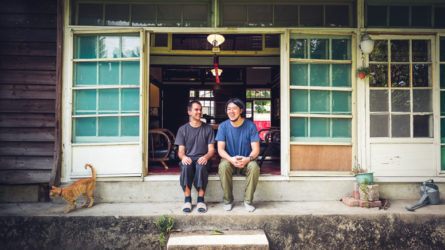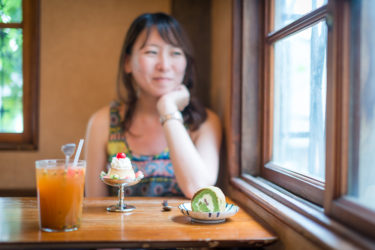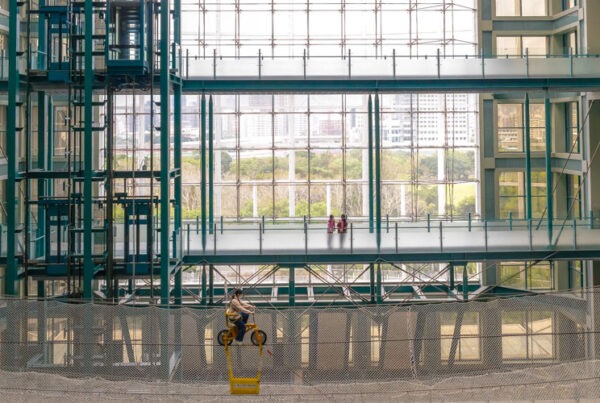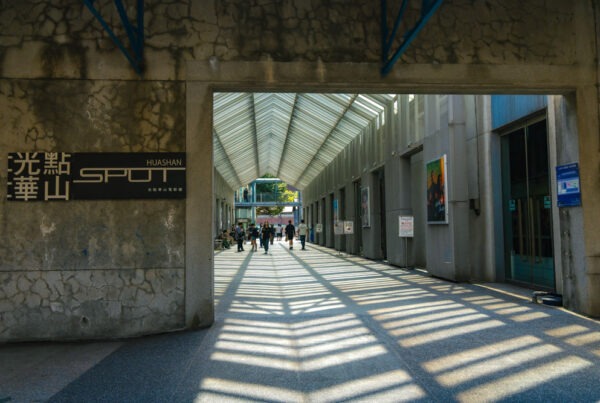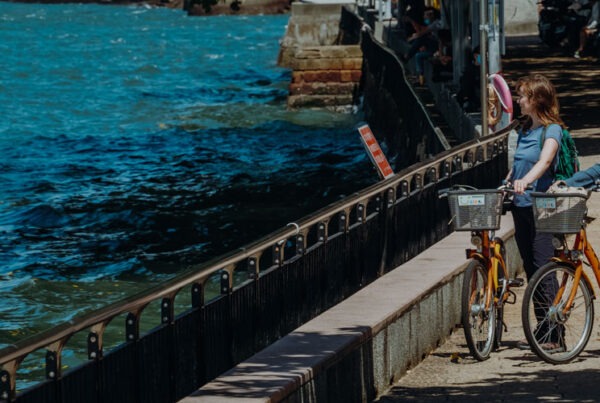Three Tainan Theme Tours – Heritage Sites, Cultural-Creative Streets, Water/Eco Outings
Text: Rick Charette; Photos: Chen Cheng-kuo

Come spend a few days in this warm and sunny coastal city of deep-current heritage by heading out on three self-guided tours of distinctive theme and character: Explore its heritage sites, its bloom of cultural-creative zones where old-time shophouse streets have been rejuvenated, and its ever-growing corps of educational and entertaining water- and eco-fun attractions.
The city of Tainan, in Taiwan’s southwest, is the birthplace of modern Taiwan history. The capital for most of the island’s days under imperial Chinese control, the local population looks upon Tainan as the Japanese do upon ancient Kyoto and the Koreans upon antique Kyongju. The classic Tainan tour, a celebration of the proud legacy embodied in its compelling heritage sites, has in recent years been made that much more rewarding with renovation and/or significant augmentation of sites for the pleasure of both residents and tourists.
The city, various government authorities at the national level, and private citizens are also hard at work comprehensively enhancing local quality of life – and the tourist experience – in other fields. One key area in this quest is the cultural-creative realm; one after another old, narrow shophouse street and neighborhood enclave has been magically transformed into a cultural-creative space teeming with boutique stores, small art galleries, and eclectic restaurants, cafés, and teahouses, with the original architecture and community history respected and celebrated.
On another front, more and more of the coastal area’s deep stock of saltwater-focused resources, from lagoons to mangrove swamps to canals leading to harbor and sea – long dedicated almost exclusively to marine-resource industries – are now being rededicated for tourist-drawing eco-learning activities.
Heritage Sites & Tourist Hotspots
Anping Fort
Taiwan’s modern history began in today’s Anping District. And it all began in Anping at the spot today called Anping Fort (No. 82, Guosheng Rd, Anping Dist.), site of the ruins of a grand citadel built by the Dutch.
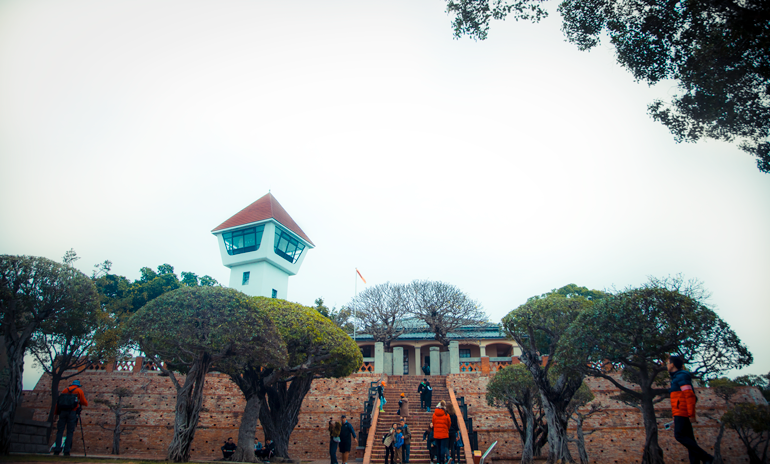
The stronghold, originally called Fort Zeelandia, was built at the north-end head of a great sometimes sandbar/sometimes silt island (at high tide) that jutted out from the mainland. Along with other offshore silt islands, it formed the sea-side wall of a large “Inner Sea.” The Dutch sought to rule Taiwan from 1624 to the time they were ousted by the celebrated Ming dynasty loyalist Koxinga in 1662. The Inner Sea eventually silted over, and the fort’s ruins are today stranded far from the coast. Much of our theme-tour time in the pages to come is spent where the Inner Sea once rippled, and in the solid land/open water transition area between Anping Fort’s position and today’s Taiwan Strait coastline.

Tip: After viewing the historical information posted on-site, be sure to tackle the steep stairs in the maritime-customs tower, built in the 1940s, delivering you to sweeping views in all directions, including the now far-off coast.
KLOOK:
Tainan Historic Sites Pass (Tainan Station Pick Up)
Anping Old Street
Right beside Anping Fort are a number of narrow eatery-stuffed streets collectively called Anping Old Street, where seafood is bien sûr the compelling draw. This was the site of the first Dutch settlement, and font of “Taiwan’s 1st Street” – the first-ever commercial street to form. There are many famed eateries here with long histories; shrimp rolls are an Anping Old Street compulsatory treat, Taiwan’s answer to Japan’s tempura, and Chou’s Shrimp Rolls (No. 125 Anping Street, Anping Dist.) is one of the best restaurants serving the delicacy.


Anping Tree House
Just north of Anping Fort is a heritage-architecture tandem only opened to the public in recent years, the Old Tait & Company Merchant House (No. 108, Gubao St., Anping Dist.) and, directly behind, the Anping Tree House, both built by a British trading firm after the Second Opium War forced China to open ports to Western trade in 1858. The facilities were later abandoned when the Japanese targeted the lucrative opium and camphor trades during their colonial rule of Taiwan. Inside the breezy, graceful arcaded colonial-style trading house are displays on the area’s imperial-era history. The treehouse, originally conjoined warehouses, has been completely overrun by massive banyan trees, creating a fairytale maze.



Tip: It’s almost impossible to capture the character of the tree house with still photos. Prepare for video shooting; the best 360-degree sweeps are taken from the open-roof-level steel-girder catwalks.
Hotels in Anping (booking.com)
Lin Mo-Niang Park
Just south of Anping Fort is the innermost section of Anping Harbor, awaiting tour-boat exploration in our third theme tour. Overlooking its south side is a giant 16m-high hilltop statue of Lin Mo-Niang located in the breezy Lin Mo-Niang Park. Lin was the young mortal maiden who became the immortal Mazu, Goddess of the Sea, protector of seafarers.


Eternal Golden Castle
A few blocks south of the park is the Eternal Golden Castle, actually a fort (No. 3, Guangzhou Rd., Anping Dist.), built by the Chinese in the 1870s as protection against grasping colonial powers. Designed by a Frenchman, massive bastions are found at the ends of the four high, thick walls, with a moat making enemy access even more difficult. On display inside are giant cannons and archeological digs.


Tip: The fort is closely surrounded by tall trees, and a rampart-top walk along the parapets provides soothing up-close, eye-level viewing of teeming treetop birdlife. You can also travel the moat on cutesy paddleboats.
Tainan Judicial Museum
Also recommended are two newer historic attractions not far outside Anping District. The Tainan Judicial Museum (No. 307, Sec. 1, Fuqian Rd., West Central Dist.; www.judicial.gov.tw/museum/; Chinese) complex, inaugurated as the Taiwan District Court in 1914, is considered one of Taiwan’s three supreme Japanese-era works of architecture, the others Taipei’s Presidential Office Building and National Taiwan Museum. The Japanese used Taiwan as an experimental station, and as with other designs this is an eclectic mix of Western architectural traditions. A dome is its most striking feature, once paired with a tower that soars no more but which is still “on view” – in a room of whimsy with a large replica seen in a deep well that is in fact a reflection of the real thing hanging upside-down from the ceiling.


 [/two_third_last]
[/two_third_last]

KLOOK:
Tainan Classic Attractions Day Tour
Old Taiwan Magistrate Residence
The Old Taiwan Magistrate Residence (No. 1, Weimin Street, East Dist.; www.otmr.com.tw), built in 1900, was used as a residence by visiting Japanese royals, most notably the future Emperor Hirohito during his 1923 grand Taiwan inspection. Have your photo taken with him (a life-size cutout) in the history-display area.

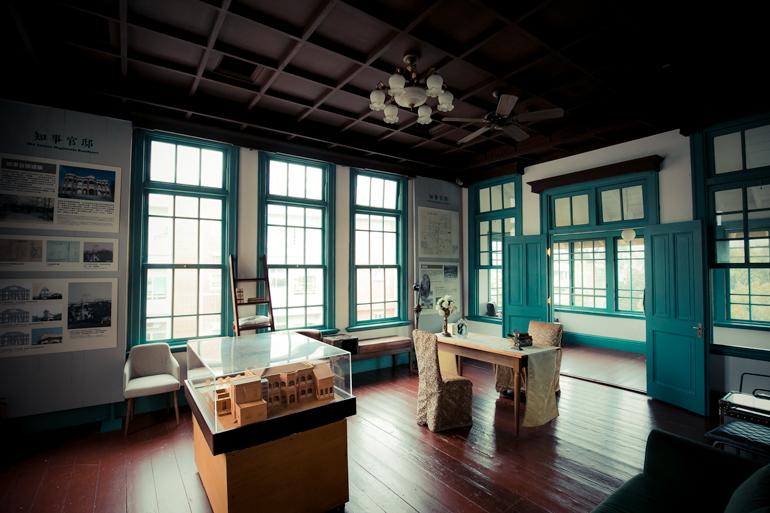
Cultural-Creative Youth Culture on Old Streets
Over the past decade or so, a number of historic streets and alleys in Tainan’s old neighborhoods long down on their luck have undergone a renaissance, the prime movers young entrepreneurs simultaneously following two dreams: to preserve a chosen bit of the architectural history of the city they love, and to express their cultural-creativity in self-financed business ventures that can provide them a living wage. These long-quiescent enclaves are now alive with artsy-style cafés, teahouses, eateries, boutiques, artist studios, and other interests.
Blueprint Culture and Creative Park
This park (opened in 2015) is a narrow-lane complex of renovated simple, cement-walled dormitories originally built by the Japanese to house judicial-authority employees; the aforementioned Tainan Judicial Museum is nearby. The dorm buildings are today home to an attractive cluster of artisanal outlets and creative eateries. The “blueprint” refers to a mesmerizing entrance-point 3D artwork that transforms a solid wall into a glowing architectural blueprint.



Tip: The “hidden-away” Little Secret (No. 17, Ln. 689, Sec. 1, Ximen Rd., South Dist.; www.facebook.com/littlesecret17) restaurant is the go-to foodie haunt here. The emphasis is on bringing cultural-creative flourishes to familiar Taiwanese noodle classics, each dish celebrating a regional icon ingredient such as premium Kinmen kaoliang (sorghum) liquor, Yunlin County sesame oil, Tainan milkfish, etc. Signature creations include the blanched beef soup with spinach noodles and black sesame-oil chicken.



Xinyi Street
At the western end of old, exceedingly narrow Xinyi Street, which stretches just a few hundred meters, is the small, imperial-style Duiyue Gate. Built in 1836 by China’s Qing imperial government, this is the only gate from the old walled city still in use today (note the white stone used for the base, Penghu stone originally used as ballast in ships sailing from the Penghu Islands). In recent years young entrepreneurs have been encamping in this still-bustling neighborhood, rich with traditional shophouse-style heritage residences and three venerable, well-maintained temples.

Cloudy Mountain Tea Shop (No. 120, Xinyi St., West Central Dist.; www.facebook.com/atimetotealab/), run by a Taipei refugee who fell in love with the Tainan character, is directly before a temple plaza and is a neighborhood “place for chatting.” Linger over premium teas and browse the for-sale teas and other small-batch organic produce sourced from around Taiwan, including delicious Chiayi County cane-sugar cubes.


Next-door Fox Café (No. 118, Xinyi St., West Central Dist.; www.facebook.com/CassetaVolpe/) is a laid-back space of specialty imported coffees flush with the works of the artist-owner, English name “Fox” – a fellow, not a femme – and collectibles gathered during his globe-trotting.
[two_third] [/two_third]
[/two_third]
Zhu Xin Ju restaurant (No. 69, Xinyi St., West Central Dist.) is in a lovingly restored shophouse built in 1876. The culinary theme is “Grandma’s flavors” – i.e., faithful preservation of old-time Tainan-region dishes, specifically those of the owner’s own grandma. Meals are served banquet-style (7 dishes, 1 soup); each patron pays NT$500, and the menu changes daily depending on what is best-in-market. Regular table “bests” are the Tainan-style milkfish tripe and black-pig sausage.




Tip: The owner, a passionate hunter of Taiwan antique gems, invites diners to view his treasures in the restaurant-rear former living quarters and old shophouse directly across the street, the latter set up like a vintage mom-and-pop sundry-goods store (which it once was), bursting with bygone-days movie posters, kids’ toys, soda-pop and alcohol bottles, brand signs – and a magnificent apothecary cabinet.
Zhengxing Street
Less than a decade ago Zhengxing Street was an old, tired family-shop backwater. The Rainbow Is Coming boutique (No. 100, Zhengxing St., West Central Dist.; www.rainbowiscoming.com) then opened, and the owner injected new community spirit. Extant shops have undergone thorough makeovers, new outfits have opened, and Zhengxing is today among Tainan’s most popular shopping/eating streets.


Tip: Look for the scores of cartoon cat drawings outside shops, cat caricatures of the respective owners. The practice started as a celebration of the neighborhood’s cat population. Rainbow Is Coming’s bestsellers are its cat-theme designs.

The Place Tainan
This haute chic new boutique hotel, a member of the upmarket Hotel Royal Group, is situated at one end of a monstrous block-style retail/entertainment/leisure complex, brand-name boutique-outlet mall in the middle, cinema complex at the other end. The contemporary-décor hotel has minimalist-theme guestrooms with strong black and white schemes that create a sense of purity of space. Facilities include a restaurant, bar, café, gym, gift shop, and mini art galleries.


The chefs at the high-floor GanCui Restaurant, which looks out beyond the city’s high-rises toward the south, present a fusion of ingredients, seasonings, and cooking techniques from the Tainan region and Italy; the East/West breakfast buffet is among the best this writer has enjoyed in Taiwan, notably the range and quality of the gourmet breads and imported cheeses and the first-rate salads.


GanCui shares its scopious space with the open-concept Bar 21, which offers patrons preeminent alcohol brands from around the globe and an inventive array of self-concocted cocktails.



The first-floor gift shop, set up like a mood-lit art gallery, showcases the best and most representative of Taiwan’s cultural-creative designer gift and souvenir items, and the area fronting elevators on each guestroom floor is a true mini gallery, created by local and international artists, each celebrating a distinctive element of Tainan life such as the city’s famed night markets and inventive street-food culture.
(Room rates start at NT$8,000; breakfast included.)
The Place Tainan (台南老爺)
Tel: (06) 236-6168
Add: No. 368, Sec. 1, Zhonghua E. Rd., East Dist., Tainan City
(台南市東區中華東路一段368號)
Website: www.hotelroyal.com.tw/tainan
Hotels in Tainan (booking.com)
Water Fun & Eco-Experiences
Anping Canal Cruise
In the section on Anping Fort earlier, Tainan’s now-disappeared Inner Sea was introduced. Today only vestiges of this large body of water remain, and the coastline is far off from where the silt islands that formed its outer wall once floated. This is now a low-lying region of dry land, fish, shrimp, and oyster farms, salt farms, lagoons, mangrove swamps, Tainan’s sole island, and old canal pathways.

In late 2017 Tainan launched Anping Canal sightseeing cruises. This waterway is Anping District’s old transport canal. Boats start from Anping Harbor close to Lin Mo-Niang Park, traverse the harbor, pass by the Eternal Golden Castle, cross Kunshen Lake (Tainan’s ship harbor), enter the canal’s south end, and finally exit the north end back at Anping Harbor. The tour length is 10km, time about one hour. A memorable thrill for partakers is the call to duck below the gunwales when passing under three low-slung older bridges.


(There is not fixed timetable and you need to make reservations in advance at tel. 0903-232-168; website: www.facebook.com/anping.yacht.tour.)
Yuguang Island
Yuguang Island, today Tainan’s sole offshore island, is a mere stone’s throw-plus from the Eternal Golden Castle. It is reached by a short bridge just south of the fortress; the canal-tour boats pass underneath. A raised boardwalk takes visitors through the island’s forest cover to a long, crescent-shaped outer beach, where people picnic, small sailboats ply the gentle waters, and fishermen move about tending their open-water oyster-farm plots.


Taijiang National Park
A short distance from the coast in Annan District, right above Anping District, is the striking Taijiang National Park Visitor Center. Taijiang National Park (www.tjnp.gov.tw) is a watery world of estuaries, sandbars, tidal flats, old irrigation canals and small-craft shipping channels, mangrove swamps, wetlands, and aquaculture farms – much of these vestiges of the old Inner Sea. The white-walled buildings of the visitor complex, built on stilts above retired fish farms, resemble traditional fishermen dwellings and circle a faux “lagoon.”

Tip: At Sicao, not far from the visitor center, take guided-tour boat excursions, one through the narrow Mangrove Green Tunnel, a long-disused section of Taiwan’s first canal, built in the 1870s for transport of sugar and salt from local farms, and the Taijiang Boat Tour on larger mangrove forest/river channels.




Qigu
North of this is coastal Qigu District, home to the Black-faced Spoonbill Reserve, a key site in the ongoing international campaign to help the magnificent, critically endangered black-faced spoonbill, a waterbird that migrates between North Korea to Southeast Asia. North of the reserve is the sea-like Qigu Lagoon, festooned with a veritable Roman legion of aligned oyster racks.

Tip: The sunsets as seen from the lagoon’s boardwalk-style Seaview Pavilion are perhaps the Tainan coast’s most sun-tillating.
Salt Fields
North of Qigu is coastal Beimen District. Just south of the fishing village of Beimen are the Jingzaijiao Tile-paved Salt Fields, Taiwan’s oldest salt fields, created in 1818. This site is a showcase example of how the bottom of evaporation ponds were paved with pottery shards, producing cleaner salt and making harvesting easier.

Tip: Demonstration workers show how everything is done, and you can also do you own DIY salt-cone piling, so wear proper shoes.
Nankunshen
Just north of Beimen village is the grandiose Nankunshen Daitian Temple complex, visible from far off across the flatlands. This is the largest of Taiwan’s many temples dedicated to what are called the “plague gods.” In imperial times effigies of these gods would be placed on junks at sickness-stricken places and sent off to sea; temples would often be built to appease them at places the boats drifted ashore. This spot, place name Nankunshen, is said to have been visited by such a craft in 1662.

Tip: Sharp-eyed readers will have noticed the use of “kunshen” twice to this point, in the just-mentioned temple name and Kunshen Lake earlier. “Kunshen” means “whale back;” Tainan’s once-many offshore silt islands were dubbed “whale backs,” referring to their shape. Yuguang Island is, in fact, also called Sankunshen/ “Third Kunshen,” and another name for the Eternal Golden Castle is Erkunshen Fortress / “Second Kunshen Fortress.”
Vanaheim
Vanaheim, a coast-side eco-theme resort, is not far north of the temple. You “camp” here – in simple, sturdy structures resembling yurts, big enough for two beds and a small toilet and shower. The accommodations sit on the edge of a large, busy mangrove forest; tectonic activity has caused some coastal land in this region to subside, and mangroves have been encouraged to once again take root where saltwater aqua farms long flourished.



Included in a visitor’s stay package is a guided mangrove-channel boat tour and an eco-tour along a long forest-wending raised boardwalk and the beach/tidal flat between forest and Taiwan Strait.
Vanaheim (愛莊園)
Tel: (06) 786-5355
Add: No. 73-11, Shuangchun, Shuangchun Borough, Beimen Dist.
(北門區雙春里雙春73-11號)
There is regular rail service to downtown Tainan Railway Station and high-speed rail service to HSR Tainan Station southeast of downtown (the two stations are connected by regular commuter-train service). The HSR station has car-rental service desks; reputable scooter-rental shops are found outside the downtown station. Another option is the Taiwan Tourist Shuttle hop-on, hop-off bus service, with a number of Tainan touring routes offered (www.taiwantrip.com.tw). The city’s new double-decker sightseeing buses travel around the old city core, and its T-Bike public bike-rental network also provides great value (tbike.tainan.gov.tw).
Beyond the Taiwan Tourism Bureau website (eng.taiwan.net.tw), these sites are also recommended: Southwest Coast National Scenic Area (www.swcoast-nsa.gov.tw), Taijiang National Park (www.tjnp.gov.tw), Tainan’s Tourism Bureau (www.twtainan.net).
KLOOK:
Taiwan High Speed Rail (THSR) Tickets to Tainan with 24hr. Car Rental
Old Neighborhood in TAINAN: 321 Art Alley Settlement
taiwaneverything.cc/2017/07/31/321-art-alley-settlement/
Tainan Streets and Alleys — Culture, Eating, Shopping
Further reading on other sites:
HOPONWORLD: THE BEST THINGS TO DO IN TAINAN, TAIWAN
The Beautiful Island/Polish Girl in Taiwan:
Visiting Anping: Sio House and History of Salt
Visiting Anping: Oyster Shell Kiln Museum
Visiting Anping: Fort Zeelandia and Eternal Golden Castle
About the author

Rick Charette
A Canadian, Rick has been resident in Taiwan almost continually since 1988. His book, article, and other writings, on Asian and North American destinations and subjects—encompassing travel, culture, history, business/economics—have been published widely overseas and in Taiwan. He has worked with National Geographic, Michelin, APA Insight Guides, and other Western groups internationally, and with many local publishers and central/city/county government bodies in Taiwan. Rick also handles a wide range of editorial and translation (from Mandarin Chinese) projects.


